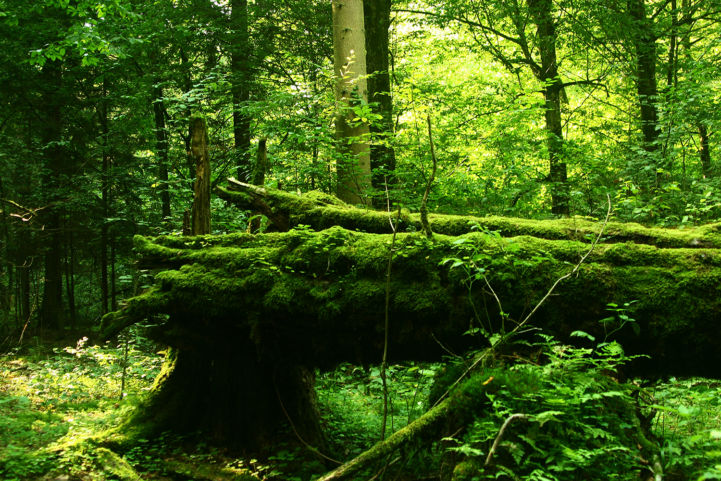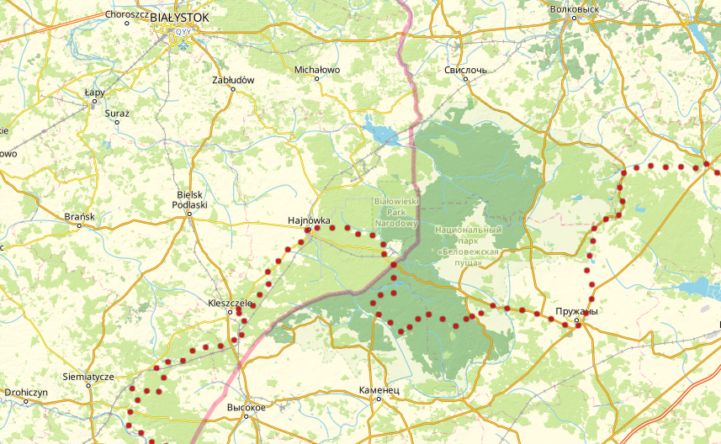The Białowieża Forest: a giant from the past on EuroVelo 2 – Capitals Route
Forests and old-growth forests
Forests are home to 80% of the Earth’s biodiversity (1) and they are carbon sinks (as in they absorb carbon dioxide rather than emit it). Their protection is of paramount importance, because they are a key weapon in the front line against climate change and biodiversity loss. Forests used to be the main form of vegetation which covered most of Europe, but due to human activity, more than half of the continent’s original forest coverage disappeared by the end of the 17th century (2). They were razed because their wood could be used to make charcoal fuel, in addition to making way for agriculture, livestock grazing, manufacturing and construction.
However, there is some hope because forest cover is increasing in Europe. This is because of afforestation programmes or spontaneous regeneration on abandoned land; yet dangers to these forests’ health are still present, and so good forest management is key to ensuring the resilience of forests’ ecosystems.
Old-growth forests play a special role in the protection and recovery of biodiversity. Their evolution over an extensive amount of time gave rise to various tree-related structures, such as multi-layered canopies, diverse tree species of mixed ages, with varying heights and diameters, standing dead trees, woody debris on the forest floor, amongst many other adaptations and features. All of which provide a wonderful wildlife habitat which allows a diverse eco-system to thrive (3). When these habitats are disturbed, and in some cases irrevocably harmed as a result of human intervention, it can take between a century to several millennia for forests to re-develop their old-growth characteristics. It stands therefore, that it is vitally important to protect these magical places in the first place.

The Białowieża Forest
Less than 3% of the world’s old-growth forests can be found in Europe. The Białowieża Forest, which straddles the Polish and Belarussian frontiers and extends over 308,580 hectares, constitutes one of the largest and best-preserved parts of the primeval forest that used to cover the European plain. Interestingly, the forest was protected and avoided massive tree cutting and land use changes in previous centuries because it used to be a hunting ground of the Tsar (4). Nowadays, most of the forest is on the Belarusian side and is protected as the Belavezhskaya Pushcha National Park. On the Polish site, part of the forest is protected as the Białowieża National Park.
The Białowieża forest contains a wide array of old-growth forest stands, a rich variety of wildlife including 800 European bisons, and numerous species of plants and fungi (5). The forest has also been designated a UNESCO World Heritage Site. The National Park was created with the aim of preserving this incredible biological diversity, through controlling the threats and fighting them to preserve endangered species.
In order to protect this unique ecosystem, the Park was divided into three buffer zones, corresponding to various ranges of human intervention (6):
- Strict protection: 57,6% of the park area
- Active protection: 39% of the park area
- Landscape protection: 3,4% of the park area
A visit to this Forest constitutes a unique opportunity to observe biodiversity unseen anywhere else in Europe, as it is home to rare species of fauna and flora and the largest free herd of bison in the world (7).
Visiting Białowieża cycling EuroVelo 2
EuroVelo 2 – Capitals Route, starts in Galway in western Ireland and gives you the chance to visit the capital cities of Dublin, London, Amsterdam (less than 30 km from the route), Berlin and Warsaw, and to cross the Białowieża Forest on its way to Minsk, and further on to Moscow, after a journey of 5,000 km.
Although the route is not yet well developed east of the German-Polish border (as it has not been fully signed off on yet), parts of it can already be cycled, provided that the journey is well planned, and the route double checked. The itinerary brings cyclists to the entrance of the Białowieża National Park in Poland, where marked trails, viewpoints and rest areas have been installed. Though zones that are under strict protection are not accessible to visitors, the great biodiversity of the forest can be discovered in the area available for tourism and education, and the bicycle is an ideal way to explore and learn about the history of the place. Bicycles may be hired in the polish city of Narewka, just 15km to the north of the route (8).
In Belarus, EuroVelo 2 crosses the Białowieża Forest on a distance of about 50 km. The route visits Kamieniuki, tourist and administrative centre of the Belavezhskaya Pushcha National Park, where an environmental education centre and the Museum of Nature are located. The main entrance to the National Park can be found across the bridge from the village. All roads on the territory of the forest have a high-quality asphalt surface. Entering the National Park on one’s own bicycle costs a few euros and cyclists should be careful because most of the roads are quite narrow and are shared with tourist busses. The experience of crossing this enchanting forest and maybe even seeing a bison will be a most rewarding one!
Additional information on EuroVelo 2 – Capitals Route in Belarus can be found on this website and in this guide in Russian and English. GPS tracks of the route can be downloaded here.

Ancient woodlands across Europe
Old-growth Forest areas can be found elsewhere across Europe, but in most cases, they are much smaller than the Białowieża Forest. Some of the largest ones are the intact virgin forests that can be found in the Carpathian mounitains, which lie mostly in Ukraine and Slovakia. Moreover, in Bulgaria, the Central Balkan National Park is host to ancient beech forests which have been included as UNESCO World Heritage Sites. Cycling tourists travelling on EuroVelo 11 – East Europe Route or EuroVelo 13 – Iron Curtain Trail can take a few days to visit these special places, as the old-growth forests are not located directly on the EuroVelo routes.
As anyone who ever travelled by bike well knows, cycling tourism has a knack for creating a special connection with the places that you visit. The active exploration of the variety of the natural world is often a turning point that stimulates creativity, bringing a fresh view of the world and a renewed meaning to life. So, wait no more and explore the wonderful and inspiring old forests that can be found across the EuroVelo network! In the Bialowieza Forest, amidst the pine, oak, spruce, and beech trees that compose the bulk of the forest, you will find trees that are much older than any human can ever hope to live (9). However, please make sure to leave no trace of your visit so we can to take good care of our fragile ecosystems! You can follow the 7 principles of the Leave no Trace movement, stated at the end of this article.
Author: Florence Grégoire
(1) https://ec.europa.eu/environment/forests/index_en.htm
(2) https://www.eea.europa.eu/themes/biodiversity/forests
(3) https://en.wikipedia.org/wiki/Old-growth_forest
(5) https://www.worldwildlife.org/ecoregions/pa0412
(6) https://bpn.com.pl/index.php?option=com_content&task=view&id=27&Itemid=211
(7) https://bpn.com.pl/index.php?option=com_content&task=view&id=633&Itemid=280&lang=en
(8) https://bpn.com.pl/index.php?option=com_content&task=view&id=652&Itemid=298
(9) https://www.poland.travel/en/discover/national-parks/bialowieza-national-park